Kanban: Definition, 6 Rules, and its Benefits
Kanban is a crucial part of the Just in Time (JIT) system, which we discussed…
Sean Thobias
May 17, 2025
The last chapter explored the customer development process, a framework mentioned in “The Startup Owner’s Manual” by Steve Blank and Bob Dorf. This method is all about understanding what customers want and need.

The model follows four steps:
In this chapter, we’ll get down to business and see how to apply this idea to building a company. We’ll look at the practical steps to make your startup connect with your customers better.
We’ll also dive into the Customer Development Manifesto, which has 14 principles to guide startups like yours. These principles will help you stay focused on your customers and set you up for success.
Read more: Startup Essentials: Key Definition and 9 Mistakes to Avoid
The customer development process allows entrepreneurs to test their ideas before going all-in when building a company. It helps them determine if their products solve a problem for their potential customers.
Instead of mindlessly investing time and money, entrepreneurs follow a systematic four-step approach to validate their ideas. Here’s a simple step-by-step guide to implementing the customer development process:
Starting a startup begins with your idea for a new product or service that meets your customer’s needs and how you plan to reach many customers. Customer discovery helps you avoid wasting money and getting nothing in return. Your primary objective is to turn your initial ideas about the market and customers into solid facts.
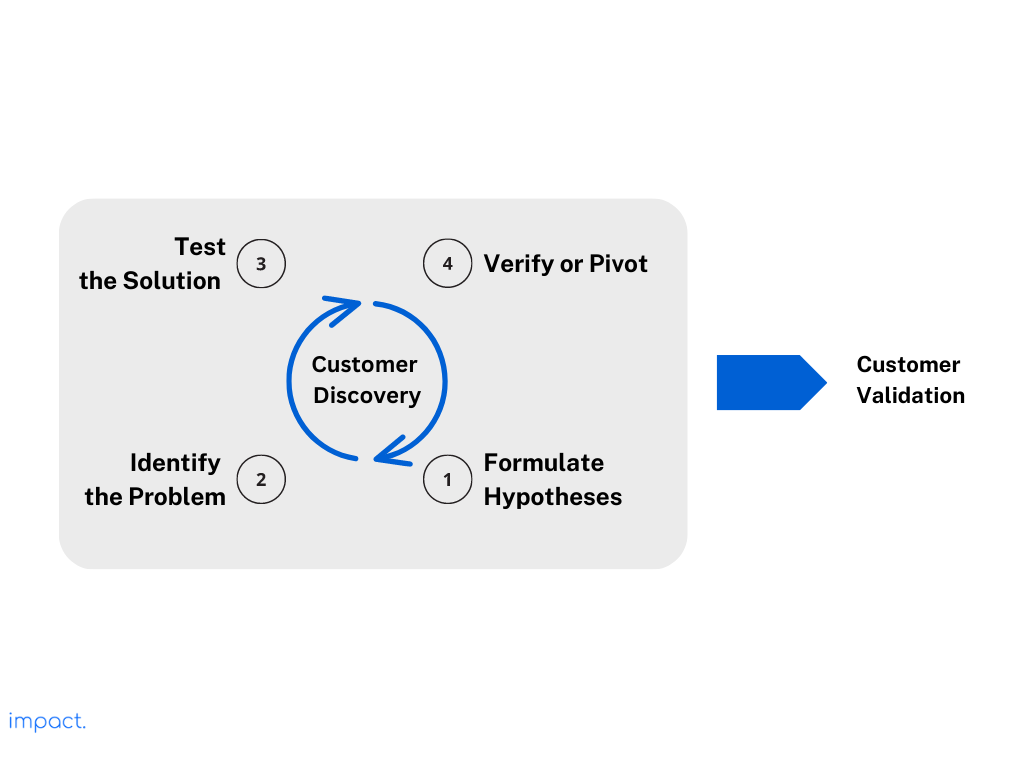
To get started, have a clear vision and assumptions in mind. Understand the problem thoroughly before finding a solution. Identify the target audience you want to help and develop different potential solutions. Use your research and market knowledge to create these hypotheses.
To start a successful startup, first, find a big problem or something people need but don’t have yet. This problem should be substantial enough that people want a solution for it.
Don’t just sit inside and guess what customers want. Go out and talk to them about where they live. Spending ample time with your customers is crucial for profoundly understanding their needs. These are some actions that you can take at this stage:
This process requires extended engagement, possibly lasting months. Remember, your product should be designed for a specific group of people, not for everyone. And don’t wait until you have customers to start building your product. Start building it early, even if you’re unsure if anyone will buy it yet.
To test your solution for the identified problem, you’ll need to develop a Minimum Viable Product (MVP) or a basic version of your solution that addresses the issue. The MVP should include your product, pricing, features, and other business model components.
Next, offer the MVP to a small group of early adopters. Early adopters are enthusiastic individuals who have a problem or need and understand they have one. They actively search for a solution and have a timetable for finding it. These early adopters might already have a temporary solution because the problem is bothering them significantly.
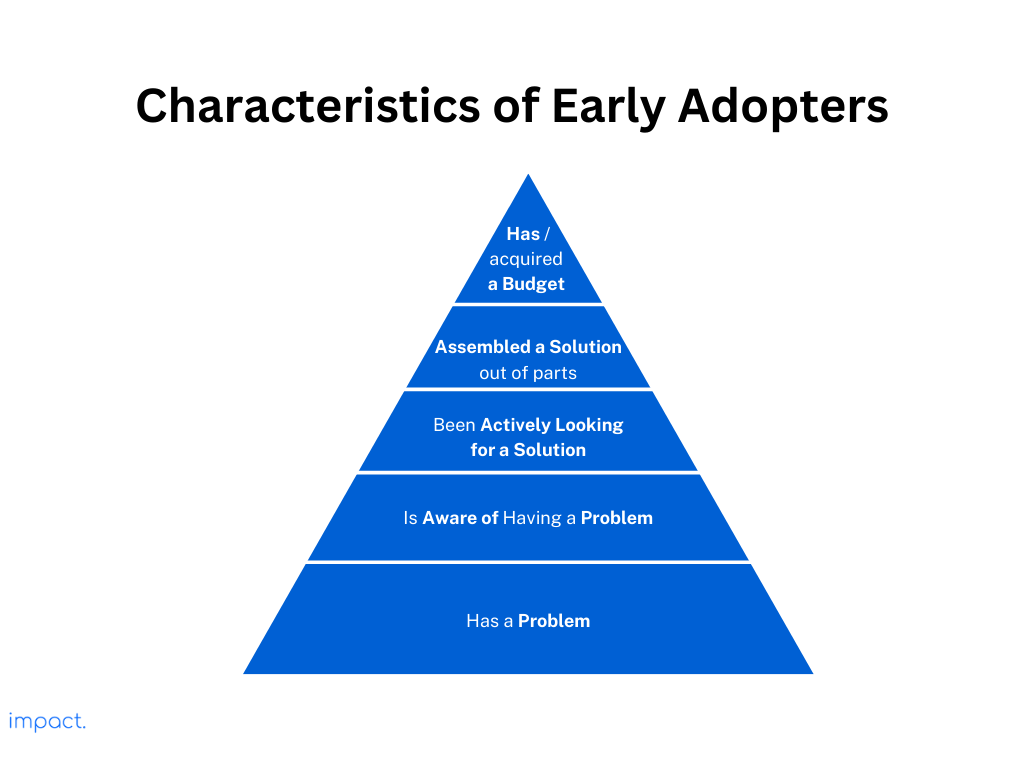
Observe how potential customers use your MVP and collect feedback. Early adopters can help promote your product through word-of-mouth. Compare their responses to determine success or areas for improvement.
In the final phase of customer discovery, you must verify and pivot as necessary. Look closely at the feedback you received from potential customers in both problem and solution testing stages. This feedback should have given you a good understanding of their needs, how much they’re willing to pay, and the potential customer base.
The key questions are whether there is enough demand for your product and whether your solution effectively addresses the problem. If the feedback is positive and supports your initial assumptions, you can move on to the customer validation phase.
However, if the feedback indicates significant changes are needed, be open to pivoting your product strategy to better align with customer needs. Remember, adapting and refining your approach based on what you learn from potential customers is essential.
In customer validation, the goal is constantly testing the product’s potential. This phase involves a series of pass/fail tests to assess whether a match between the product and the market is strong enough. It is a crucial step to know if your business can scale. Like the customer discovery phase, customer validation also follows four essential steps.
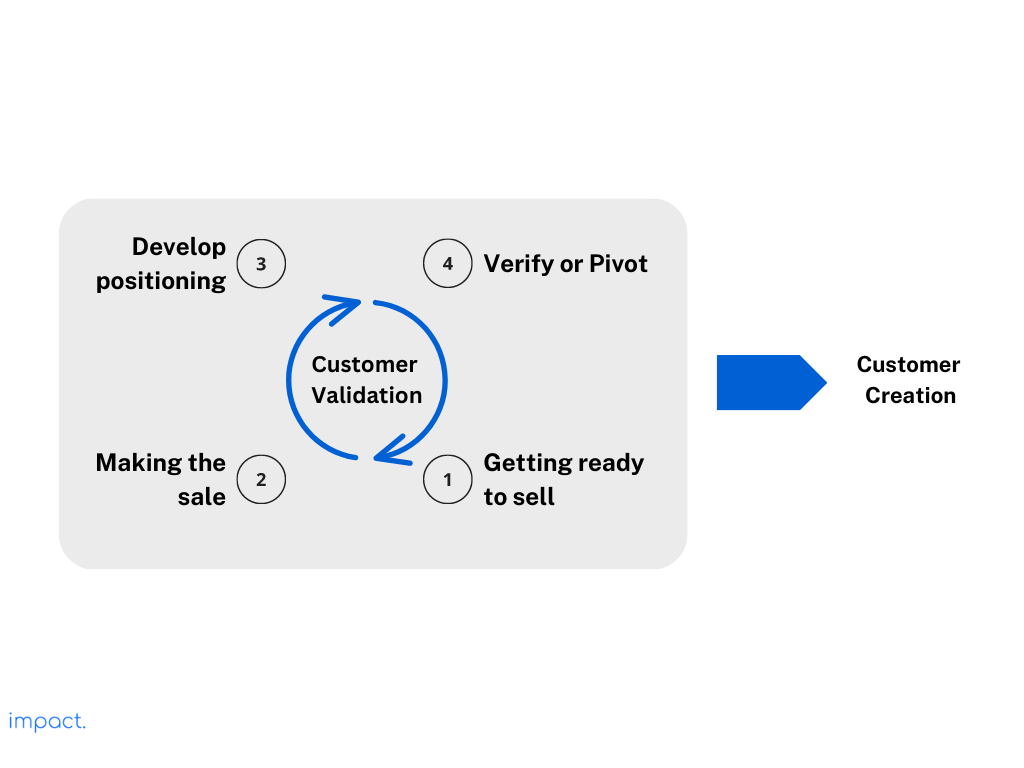
Prepare your product or service for the market using the insights from the Customer Discovery Phase. As you gear up to make sales, focus on these six critical activities as you move forward:
By completing these activities, your team will be well-prepared to enter the market and effectively engage with potential customers, making your early-stage venture a strong contender in the industry.
This step determines if your business model can work well in the real world. Startups use materials like brochures, PowerPoints, product demos, or mockups to gather valuable insights during meetings with potential customers.
Founders need to actively participate in selling to test their business model. The main objective is to determine if customers are interested in buying their product and if the value proposition is valid.
To do this, reach out to potential customers with your Minimal Viable Product (MVP). The feedback you receive from these interactions is essential for refining your product presentation, sales roadmap, and channel plans. This process helps you understand if your business can repeat, scale, and become profitable.
In this step, you already have some orders and enough customer information to work with. It’s time to develop and refine your product and company positioning.
Test this positioning with industry experts, analysts, and a broader customer audience. Make sure to communicate the unique value of your product or service to potential customers. Highlight how your offering solves their specific problems and stands out from competitors.
Customer validation is confirmed when you see actual orders, users, or clicks—not just survey responses or casual chats. It shows that customers accept your minimum viable product and that there is a real market. You also figure out how to consistently reach these customers and create a scalable plan to sell your product to many more of them.
You can start enjoying the benefits once you’ve confirmed that customers like your idea. But before that, there are some challenges and work to ensure everything is verified and ready to move on to the Customer Creation phase.
If things don’t go as expected, like in the Customer Discovery phase, you may need to make changes (pivot). It could mean adjusting the design, changing the messaging, or switching to an entirely new product.
Once you have confirmed that customers are interested in your idea, you move on to this step to implement your business plan. During the Customer Creation Phase, your main goal is scaling your startup. Here are the steps involved in this phase:
During this step, your main goal is to create a well-planned strategy to reach more people and get potential customers interested in your product or service.
Identify the most effective channels to communicate why your product is unique and worth trying. These channels could include social media, online ads, content marketing, emails, or traditional methods like print ads or billboards.
Make sure your marketing messages connect with your target audience. Show them how your product can solve their problems and benefit them.
Now that you have a marketing and sales plan, it’s time to implement it and reach a larger group of customers. Your goal is to attract more customers and grow your user base.
To attract more customers and grow your business, focus on these steps:
As you implement your marketing and sales plans, consider essential metrics (KPIs) to see how well you’re doing. Monitor metrics like customer acquisition cost, which tells you how much money you spend to get each new customer.
By determining the effectiveness of your marketing and sales efforts, you can ensure the success of your business. With careful strategy implementation, you can expand your customer base and increase your chances of achieving growth.
Read more: Unlocking Growth: 19 Traction Channels for Business Success
Once your company successfully scales, you enter the Company Building phase. Here, your business transitions from a startup to a mature company. Some steps involved in this phase are as follows:
As your business grows, build a team that works well with your abilities and shares your company’s vision. Look for people who are enthusiastic about the product and dedicated to making it successful. Surround yourself with like-minded individuals to support and drive the company forward. A passionate and committed team will enhance your chances of achieving your goals and vision for the business.
To handle more customers effectively, improve your internal processes. Streamline your operations, manage resources efficiently, and provide excellent customer support. These changes will help you accommodate the growing customer base and deliver better service. By optimizing your internal processes, you can enhance your overall business performance and ensure customer satisfaction.
Create a culture where continuous improvement and innovation are valued. Encourage employees to try new things and learn from mistakes. This way, you can drive the growth and progress of your product and company.
By embracing a culture of learning and adaptability, your team can stay ahead in the market and find better ways to serve customers. Don’t be afraid to take risks and embrace change as opportunities for improvement. It will lead to better products, happier customers, and a more substantial business overall.
Building a company using the Customer Development Model is not an easy task. It requires real effort, and you can’t pretend to do it. Changing the way to build a startup requires a serious commitment.
Steve Blank has 14 critical principles for startups using the Customer Development process. Think of these principles as rules that both small and big companies should follow when they embrace this approach. Remember these principles from the beginning and review them regularly as you build your business.
Step outside your office to interact with potential customers directly. Avoid relying solely on internal assumptions; instead, validate your ideas and hypotheses by engaging with real customers in the field.
Combining customer development with agile development is a powerful way for startups to create products that customers love. Agile development involves building products in small, functional steps and making quick adjustments based on feedback.
This integration means startups get valuable insights from real customers throughout product development. The startup ensures the product meets their needs and preferences by involving potential customers.
With customer development and agile working together, startups can be more responsive and adaptive to customers’ wants. This customer-centric approach leads to better products and happier customers in the end.
There’s an essential difference between existing companies in startups: startups often experience failures. But don’t worry; failures are learning opportunities. Not all initial assumptions will be correct, and that’s okay. Use failures to improve and find what works best.
Failures are a natural part of the startup learning process. You’ll run many tests; some will succeed, while others won’t. When things don’t work out, successful founders adapt to the new information, figure out what needs fixing, and take action decisively. So, embrace failure, learn from it, and keep moving forward.
Pivoting is a crucial part of the customer development process. It means making significant changes to your business model based on customer feedback. You continuously improve your product and strategies by listening to customers. You should be open to pivoting to meet customer needs, and market demands better if needed.
A pivot doesn’t always mean completely changing your entire company. Sometimes, it’s just about addressing one significant problem or changing a specific area. When to pivot depends on your startup’s situation. After reviewing your company’s current status and prospects, it should be a carefully considered decision, not a quick reaction.
While some startups have experienced great success after pivoting, it’s not a magical solution for all problems. It is advisable only to pivot when necessary and after exhausting all other alternatives. It’s a thoughtful and strategic decision to ensure your startup’s growth and success.
The primary purpose of a business plan is often to appease investors who may request one. However, once you secure financing, the business plan loses its significance. Many entrepreneurs mistakenly treat the business plan as a rigid execution manual, failing to grasp that it primarily consists of unproven assumptions.
As you interact with customers and gain real-world experience, you will realize that your business plan needs to evolve. Startups should abandon the traditional business plan and embrace a more adaptable and flexible business model. Be prepared to make adjustments based on customer feedback and insights. Stay open to change and be willing to adapt your approach according to what you learn from your customers.
A hypothesis is like a fancy word for a “guess.” To turn beliefs into facts, founders need to test them. Think of your business hypotheses as experiments that need validation.

Design these experiments to confirm or challenge your assumptions. Use data-driven insights from the experiments to make informed decisions for your business. Using this approach, you can make informed decisions backed by evidence, thereby improving your chances of success.
Startups are not all the same. One significant difference is how a startup’s new product relates to the market. You must identify the type of market you are entering – it could be an existing market, a resegmented market, a new market, or a copy of a successful business.
Understanding the market type will influence your strategies. Most startups fall into one of these four market types and must choose one to commit to. Making the wrong choice can have severe consequences during the customer creation stage.
Startups need to identify and track metrics that are relevant to their growth. In the past, startups used traditional financial tools like P&Ls, balance sheets, cash-flow forecasts, and other analyses because they didn’t know what else to measure.
However, metrics for startups should focus on tracking their progress in turning their assumptions and guesses into solid facts rather than just measuring the execution of a fixed plan. It’s crucial for both the board and management to continuously test and measure each assumption until the entire business model is ready to scale into a full-fledged company.
A startup board should also track a few critical financial metrics. These include the cash-burn rate (how quickly the startup spends cash), cash runway, short-term hiring plans, and break-even point timeline.
By tracking these metrics, startups can make informed decisions, stay financially healthy, and increase their chances of success.
In startups, quick decision-making and action are crucial. Startups must respond swiftly to market feedback and seize opportunities. Speed is essential because startups face constant financial challenges, and time is of the essence.
Rule No. 4 talks about iterations and pivots but doesn’t specify how long they should take. The faster these learning, building, and pivoting cycles happen, the better the chance of finding a successful business model with available funds.
Speed is essential inside the company too. Making decisions for startups can be difficult due to uncertainty, and there may not always be a perfect solution. It’s important not to waste too much time trying to find the ideal answer and instead focus on making the best decision possible with the information available.
For a startup to succeed, it needs passionate individuals who embrace uncertainty and change. Founders and teams must be dedicated to their vision and ready to face challenges.
These people prioritize customer needs and work hard to deliver excellent products. They commit to the vision around the clock, not just during regular working hours. These passionate individuals are the driving force behind the startup’s high growth.
In startups, roles are flexible, and employees often have multiple responsibilities. Job titles are not rigid; everyone must contribute to the company’s success.
Startups need a different kind of leadership compared to big companies. They require leaders who are:
Moreover, teams in startups must be able to:
Managing your cash wisely and spending when needed is crucial in Customer Development. The main aim is not to avoid spending money altogether but to be careful with expenses while searching for a business model that can be repeated and scaled. Once you find that successful model, you can spend more confidently growing your business. It’s all about being smart with your resources until you find the right path to success.
Sharing everything learned outside the building with employees, co-founders, and investors is crucial to building a startup. It’s essential to emphasize learning from both successes and failures. Thanks to technology in the 21st century, we now have tools that make communication easier. We can share what we are learning in almost real-time with everyone who needs to know. This open and continuous communication helps the team stay informed and make better decisions to drive the startup’s success.
Customer Development’s approach to learning and discovery can be quite different from what many people in the business world are used to. If you’ve spent your career following a set plan, it can be disorienting. That’s why it’s crucial to have everyone involved in the project, from the top to the bottom, fully onboard and understanding that this process is fundamentally different.
This approach changes everything: how we behave, how we measure success, and how we perform. It’s not a linear process; it’s more like an ongoing search for a business model, sometimes taking years. So, everyone on the team must embrace and accept this unique way of working to ensure it succeeds.
The Customer Development Model is a powerful tool for entrepreneurs seeking to turn their ideas into successful businesses. It’s a systematic approach that allows you to test your concepts, ensuring that your product addresses a genuine need in the market before diving headfirst into the business world. Building a company with this model requires dedication and wholehearted commitment.
Steve Blank’s “The Customer Development Manifesto” offers 14 critical principles to guide both startups and established companies to adopt this approach effectively. These principles serve as the North Star, guiding you through building your business.
So, as you embark on your entrepreneurial path, remember these principles from day one and revisit them regularly to ensure you stay on the right course. With determination and a commitment to these principles, you can increase your chances of building a successful and customer-centric company that stands the test of time.
Our next chapter will delve into making a web startup as we move forward. We’ll explore the intricacies of creating an online presence, harnessing the power of technology, and reaching a global audience. So, stay tuned and keep these customer development principles close to heart as you embark on your journey to entrepreneurial success. It won’t be easy, but with the right tools and mindset, you can chart a course towards a promising future in the world of startups.
Blank, Steve, and Bob Dorf. The Startup Owner’s Manual: The Step-By-Step Guide for Building a Great Company. 2020.
Impact Insight Team
Impact Insights Team is a group of professionals comprising individuals with expertise and experience in various aspects of business. Together, we are committed to providing in-depth insights and valuable understanding on a variety of business-related topics & industry trends to help companies achieve their goals.
See how our software provides better value.
Speak with our consultant to explore how we can improve your accounting, processes, and people.
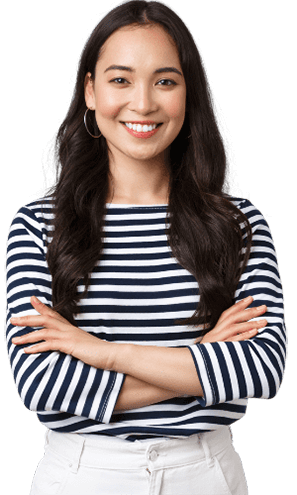
In the previous chapter, we learned about startups and the common mistakes that can lead to their failure. One essential lesson is the need to understand your customers to succeed.
In “The Startup Owner’s Manual” by Steve Blank and Bob Dorf, they talk about how many startups struggle because they lack a structured way to test their ideas. The Customer Development model is like a helpful guide that assists startups in finding a business model they can repeat and scale successfully.
Now, let’s explore the different stages and components of the Customer Development process. This process helps startups search for a business model that works by understanding and validating the needs of their target market and customers. It’s a key to making your startup successful.
In the 1990s, Steve Blank came up with the customer development process when he noticed that startups aren’t just smaller versions of big companies. He realized entrepreneurs need a structured way to find “repeatable and scalable business models.”
According to Blank, startups go through three stages before becoming big companies: search, build, and grow.
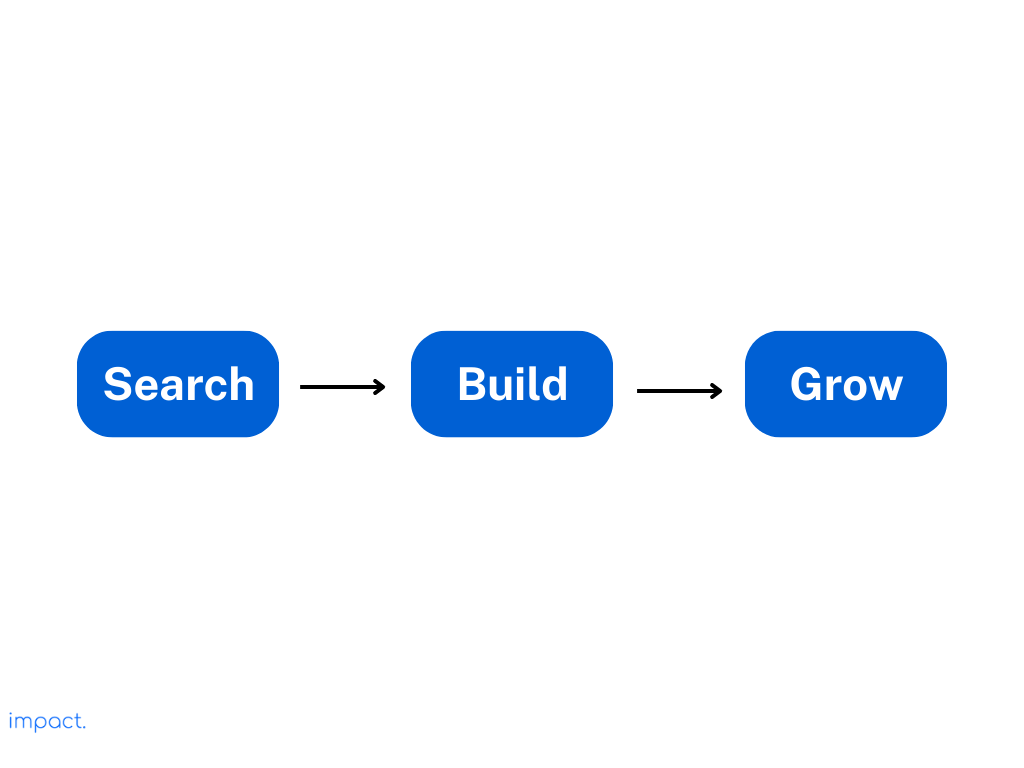
The customer development process lies within the search and build stage.
There are four steps in the customer development process:
The first two steps of the process are about finding a suitable business model (search). Once you have a model developed, tested, and proven in these initial steps, steps three and four are all about putting that model into action and making it work (build/execution).

In the Customer Development model, each step is like a circular track with arrows showing that we go through the steps repeatedly. In simpler terms, it means that startups can be unpredictable. We might face failures and make mistakes multiple times before figuring things out correctly.
Read more: Startup Essentials: Key Definition and 9 Mistakes to Avoid
Now that you know what a customer development process is, let’s dive into what exactly happens in this process. We’ll break down the whole process into four stages and explain the steps involved in each phase.
In the customer development process, the first step is called customer discovery. Here, founders take their ideas for the company and turn them into hypotheses like educated guesses. Then, they create experiments to test these hypotheses.
Steve Blank stresses the value of leaving your workspace and engaging with people directly. This approach means going out and conversing with them to gain deeper insights. In the customer discovery process, there are two main components of “getting out of the building”:
Once founders collect all the necessary information in this stage, they can move on to the next step, customer validation.
During customer validation, startups check if their solution meets customers’ needs and their business idea can work. If everything looks good, they can get ready to sell the product and grow the business.
In this phase, startups test their scalability. They see if their business can handle more customers, find the right price, and reach them effectively. They also create a sales plan for future sales and marketing teams or see how well their online marketing works with early customers.
The first two steps of the Customer Development model are essential for improving and testing the business idea. The entrepreneur makes a minimum viable product (MVP) or a prototype with the most critical features. They show this MVP to potential customers and ask for their feedback. This feedback is valuable because it helps the entrepreneur improve the product using real-world insights.
After achieving sustainable growth, startups can shift their focus to the customer creation step. However, during this validation phase, startups may sometimes discover that their initial assumptions were off-base or that the market’s needs have shifted. In such cases, a pivot may be necessary. We will discuss pivoting in detail in upcoming chapters.
Read more: Unlocking Growth: 19 Traction Channels for Business Success
Once startups have confirmed that customers are interested in their idea, they move on to the next step: customer creation. This step is where they put their business plan into action.
The main goal is to create a reliable system for attracting new customers and fueling business growth. During this stage, the team chooses their target market, sets clear goals, and fine-tunes their positioning strategy in preparation for the product launch.
At this point, startups have learned how to get customers without spending much money on marketing. They use the product/market fit they discovered earlier to develop effective marketing and sales strategies that reach a wider audience.
The way startups create customers can vary depending on their market. Some compete with established companies, while others explore new areas. Some use a combination of strategies by targeting a specific segment or finding a unique niche.
In the customer development process, the final step is company building. At this stage, the business is no longer considered a startup and no longer focuses on searching for solutions.
Now, the main goal is to scale the business. Startups move their efforts from learning and exploring to taking action. They set up organized departments such as Sales, Marketing, and Business Development, each led by a Vice President (VP).
To succeed at scaling, the company must change its organizational structure. The changes could mean hiring new people with specific skills that the current team doesn’t have. It might also involve some team members leaving if their goals no longer match the company’s goals. And in some instances, the founder might not be the best person to lead a successful company anymore.
As the company grows, the team gets more prominent, and they make operations work even better. They might create new departments to help different areas communicate and work together more effectively.
Embracing the customer development process has many benefits for entrepreneurs. It helps them succeed and create thriving businesses that meet their customers’ real needs. Here are some of those advantages:
The harsh reality of startups is that 90% fail and some don’t even survive beyond their first year. A significant factor contributing to these failures is a lack of customer understanding. Many founders assume they know what customers want, but the truth is often different.
The customer development process helps you identify your potential customer’s pain points, preferences, and unmet needs. With this valuable knowledge, you can customize your product or service to address those issues directly. This targeted approach significantly boosts the chances of your offering gaining traction and success in the market.
Startups can be chaotic, with constant changes happening all the time. Markets are constantly evolving, and what customers like can change quickly. Understanding your target customers and what they need to stay competitive is essential.
Customer development helps with this. It means talking and listening to your potential and current customers to get feedback and insights. This ongoing conversation enables you to keep up with new trends, shifts in demand, and changing customer preferences. With this valuable information, you can make intelligent changes to your products, services, or business strategies at the right time.
With the validation process, you don’t need to aim for perfection immediately. Begin with a Minimum Viable Product (MVP) that satisfies early customers. Remember, the MVP isn’t the final version, but it helps you get feedback from real users.
Releasing the minimum viable product (MVP) can be advantageous. It allows you to enter the market swiftly, gain momentum faster, and begin generating revenue while refining your product.
When you release the MVP to your target customers and ask for their feedback, you learn important things about your product. You discover what it does well, what needs improvement, and what’s missing. This feedback helps you make real-world improvements based on what customers like.
This development process helps you avoid spending too much on a fully developed product that might not match the market’s needs. Instead, you listen to customer feedback to guide your product’s growth, making it more aligned with what customers want. The constant refining based on customer input leads to a better user experience and happier customers, which can build loyalty and positive word-of-mouth.
Understanding and meeting customer needs is vital for startup success. As discussed in “The Startup Owner’s Manual” by Steve Blank and Bob Dorf, the Customer Development process offers a straightforward way for startups to find a winning business model.
The process has four steps: Customer Discovery, Customer Validation, Customer Creation, and Company Building, which are like a circle that startups repeat. It’s normal to face failures and mistakes along the way. Still, startups can discover a sustainable business model through learning and adapting.
The next chapter will focus on building a company using the customer development manifesto. This manifesto provides 14 guiding principles for founders, ensuring a customer-focused approach. By embracing these principles, startups can create a strong foundation for growth and success.
Blank, Steve, and Bob Dorf. The Startup Owner’s Manual: The Step-By-Step Guide for Building a Great Company. 2020.
Impact Insight Team
Impact Insights Team is a group of professionals comprising individuals with expertise and experience in various aspects of business. Together, we are committed to providing in-depth insights and valuable understanding on a variety of business-related topics & industry trends to help companies achieve their goals.
See how our software provides better value.
Speak with our consultant to explore how we can improve your accounting, processes, and people.

Welcome to the exciting world of startups, where innovative ideas fuel businesses and boost economies globally. The United States leads the pack with an impressive 75,056 startups; Indonesia stands strong in 5th place with 2,347.
While startups are full of ambition and creativity, it’s crucial to know that only about 40% of them become profitable, indicating their challenges.
In this chapter, we’ll introduce you to these young companies, drawing inspiration from “The Startup Owner’s Manual” by Steve Blank and Bob Dorf. We aim to equip you with the knowledge and tools necessary for your entrepreneurial journey.
A startup is a brand-new company that’s just starting. Entrepreneurs create businesses to develop a product or service they believe people want to purchase. These companies usually begin with high expenses and little income, seeking funds from different sources like venture capitalists.
Steve Blank, on the other hand, has a more specific view. He defines a startup as a temporary organization that searches for a business model that can be repeated and expanded.

To better understand startups, let us divide its definition into four parts and analyze them.
Different experts have different ideas about how startups evolve. According to Steve Blank, a startup goes through three stages before becoming a large company: search, build, and grow. Let’s take a closer look at each stage:

In the ‘search’ stage, your main focus is to find a business model that works. At this point, it’s crucial to be flexible and willing to make changes to find the right product-market fit.
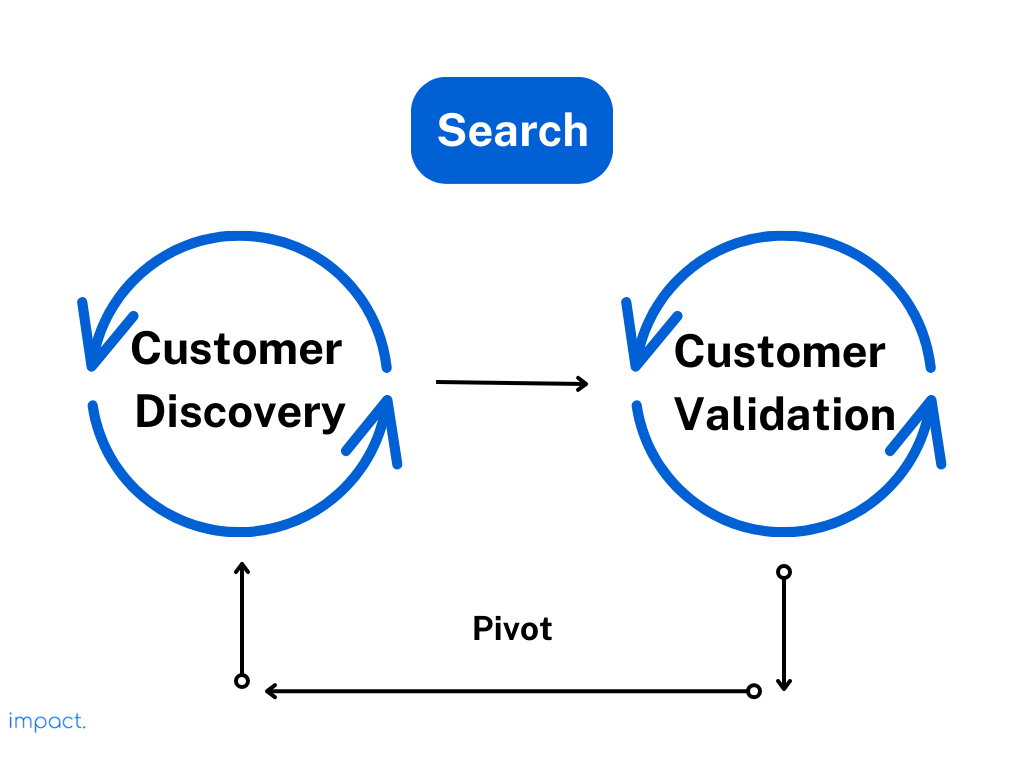
Product-market fit here means having a product that meets the needs of a specific market. It’s like being in the right place with the right thing people want.
Companies in this stage are typically small, with fewer than forty people, and they often rely on funding from seed rounds or Series A investments. To succeed in this stage, companies adopt a “do what it takes” mentality because failing to do so can lead to the startup’s failure.
After completing the initial ‘search’ stage, your business moves into the ‘build’ stage, sometimes called the ‘execute’ stage. The main goal is to scale up by attracting more customers and generating positive cash flow.
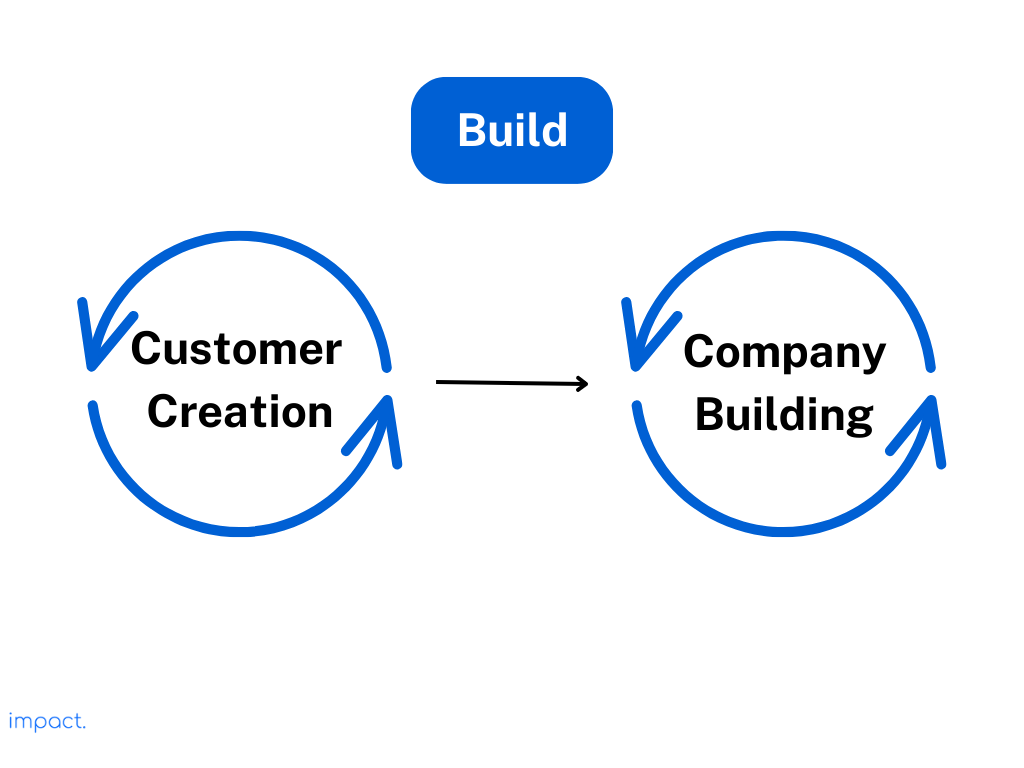
During this phase, the company typically has around forty employees and can grow to 175 to 700. If your company has venture backing, this is when a Series C or D funding round might happen.
In the ‘build stage,’ a different mindset is required. Simply having a “do what it takes” attitude may be less effective and can lead to chaos. Implementing culture training, product management, and efficient processes and procedures is essential. These initiatives will help your business operate smoothly and thrive as it expands.
According to Steve Blank, the last stage of the journey is the ‘grow’ stage. At this point, your organization has achieved liquidity, which means it has gone through an IPO, been acquired, or merged with another company. During this phase, your company keeps expanding, and you have established consistent processes and procedures based on Key Performance Indicators (KPIs) from the previous stages.
There are various types of startups, each with unique characteristics. They all begin with entrepreneurs, but they can differ significantly in terms of people, funding, and strategies.
It’s essential to grasp these distinctions because they can substantially influence your likelihood of success. Let’s explore six different startup types you should be aware of:
These ventures are all about pursuing your passion. These are businesses started by people who love technology or creative work and enjoy what they do without the primary goal of becoming huge or making tons of money. In Silicon Valley, you might find freelancers driven by their passion for technology and take up coding and UI jobs because they genuinely love it.
These startups typically hire local people or family members and provide services to their community. They’re not looking to become huge or make massive profits; their main goal is supporting their livelihood and caring for their family. Examples of such startups include businesses like dry cleaners, gas stations, and convenience stores. They usually start with their savings or borrowing money from relatives and banks.
These new ventures are launched by ambitious tech entrepreneurs who aim to make a significant impact and build billion-dollar companies. To find a workable business model, they require funding, which often comes from venture capitalists. These startups attract top talent and snowball. Companies like Google, Skype, Facebook, and Twitter were once examples of this type of startup.
These young companies have different goals compared to others. Instead of aiming to become huge companies, they want to be acquired by more giant corporations. Nowadays, creating web/mobile apps is cheaper and faster, making it easier for these startups to begin. They don’t need as much money to develop and launch their products, and angel investors are more willing to provide financial support.
Even big companies can act like startups now because they know they won’t last forever. As things change, like what customers want, new technology, laws, and competition, they need to come up with fresh and disruptive ideas.
To do this, they use lean startup practices that make them agile, creative, and competitive. Sometimes, they even create teams or incubators inside the company to work on new ideas and projects outside their usual business. This way, they stay ahead and keep growing.
Entrepreneurs who care about improving the world start social startups. These emerging companies aim to change society and the environment rather than just making money. Entrepreneurs can establish social startups as non-profit organizations, for-profit ventures, or a combination.
It’s a fact that 90% of startups fail, with 10% not even making it to their second year. Avoiding these nine common mistakes can significantly impact their success. Let’s explore each one:
According to Steve Blank, a common reason for startup failure is the assumption that founders already understand their customers. However, initially, startups have no customers, so these assumptions are like guesswork.
Turning these assumptions into solid evidence sooner rather than later is essential to improve your likelihood of success. One effective way to do this is by meeting potential customers and validating your assumptions. Relying solely on assumptions can lead to developing products or services that don’t solve customers’ problems.
The second mistake often stems from the first one. Founders may believe they thoroughly understand their customers, leading them to assume they know what their customers require.
This assumption leads them to create a complete product using traditional development methods without involving customers directly. As a result, they may not know if the product’s features will appeal to customers.
A great product or service is not enough for a startup to succeed. It must also meet the specific demands of the target market and address a genuine market need. Without this alignment, the business is likely to struggle.
In emerging companies, there’s often a fixed date for product launch, like a trade show, and they feel compelled to stick to it, even if they aren’t ready. Investors expect results tied to this launch date too.
However, launching the product doesn’t mean they understand their customers or the best marketing strategies. This approach is a big mistake, as it assumes customers will come just because the product is well-made.
Unfortunately, many startups realize only after launching that they haven’t attracted enough customers, their product doesn’t solve significant problems, or the cost of getting it to customers is too high. Avoiding this mistake is vital for a startup’s success.
Startups are different from established companies. Nothing is set in stone, and they need to find a working business model that can grow. At first, they make many guesses, but many of them will be wrong.
That’s why focusing solely on execution isn’t the most important thing. To succeed, your startup should embrace a culture of experimentation. Learn from failures and adapt your strategies accordingly.
If you avoid trying new things, your company might not improve or evolve. So, be open to experiments and learn from the results, which are crucial for success.
Traditional business plans and product development models have their advantages. They offer clear milestones for boards and founders to follow, but they may not be the best fit for startups.
Metrics like income statements and balance sheets are not helpful for emerging companies because they don’t track progress toward the most important goal: finding a repeatable and scalable business model.
As a young company, your main objective is to become repeatable and scalable, but you’re not there yet. A business plan can provide a solid structure to work towards these goals. Still, it should also be flexible and subject to changes as your startup develops and evolves. Keep it editable and adaptable along your journey.
In startups, avoiding job titles borrowed from big companies is essential. Traditional job titles may not fit a startup’s diverse and ever-changing roles. For example, the CEO can often take on various tasks in a startup.
Using generic job titles can lead to hiring mistakes, as candidates may not grasp their responsibilities in the unique work environment. It’s crucial to tailor job titles to match the specific needs and challenges of the startup.
To succeed, startups need skilled sales and marketing professionals who can effectively reach their target audience, leading to increased traction and revenue.
Don’t hire based solely on titles. Considering skills and suitability for the startup’s specific challenges is more critical. Some executives might stick to their knowledge, which might not fit startups best.
Assessing progress through product launches or revenue plans alone can be misleading. Gathering honest customer feedback and validating assumptions is crucial to make informed decisions.
Read more: B2B vs. B2C in Tech: What are the 5 Key Differences?
When you start a business, it’s essential to remember that things won’t always go in a straight line. It’s more like a rollercoaster ride with ups and downs. Just because someone likes your idea doesn’t mean everyone else will jump on board.
To measure your success accurately, you need feedback from many customers. This way, you can make better decisions for your company. Taking your time when hiring and spending money is essential. Focus on establishing stable and repeatable sales and marketing processes that you can scale up.
Achieving success and stability should be your priority before aiming for rapid growth. Growing too quickly without a solid foundation and a proven business model could lead to inefficiencies and financial strain, ultimately failing your startup.
When startups face tough times, making quick decisions without thinking things through can result in short-term fixes that don’t solve the core problems. For example, when a young organization launches its product and sales aren’t going as expected, it might quickly fire the sales VP to fix the issue.
However, the successful ones use this feedback as an opportunity to pivot or change their business approach based on what they learn. It’s not a crisis; it’s a normal part of the journey to success.
Startups are like temporary organizations searching for a workable business plan they can use to grow. Initially, startups explore and adjust to determine how their business will function. They can expand and reach more people when they discover a successful plan.
The next chapter will discuss the customer development process, a crucial part of the startup journey. This process involves four main steps: Customer Discovery, Customer Validation, Customer Creation, and Company Building.
Blank, Steve, and Bob Dorf. The Startup Owner’s Manual: The Step-By-Step Guide for Building a Great Company. 2020.
Impact Insight Team
Impact Insights Team is a group of professionals comprising individuals with expertise and experience in various aspects of business. Together, we are committed to providing in-depth insights and valuable understanding on a variety of business-related topics & industry trends to help companies achieve their goals.
See how our software provides better value.
Speak with our consultant to explore how we can improve your accounting, processes, and people.

In the previous chapter, we talked about off-page SEO and how to build links effectively. Now, let’s focus on something just as important: measuring SEO performance and understanding key metrics that show how well your efforts are working.
SEO is not just about doing on-page and off-page optimizations; you also need to measure how well your SEO is doing. Tracking these metrics helps you find areas where you can improve, make decisions based on data, and improve your website’s visibility, organic traffic, and conversions.
In this article, we’ll explore how to evaluate your SEO performance and discuss eleven important metrics that every SEO practitioner should know. We’ll explain why these metrics matter and how they can help you make your SEO strategies better. By the end, you’ll understand the metrics to track and the insights they provide to improve your SEO.
Read more: SEO Fundamentals: Key Definitions & 4 Best Practices
SEO isn’t a sprint but rather a marathon. Therefore, Evaluating your SEO performance is crucial for determining the effectiveness of your optimization efforts and making improvements where necessary. Here are four steps to help you evaluate your SEO performance:
To evaluate your SEO performance, begin by setting clear goals. Make sure your goals are specific and measurable. For example, you aim to increase the number of people visiting your website from search engines, improve your rankings for important keywords, or increase the number of visitors who take a desired action, such as purchasing or filling out a form. Setting these goals will give you a target to aim for and help you track your progress.
It’s important to watch certain numbers that tell you how well your website is doing. These numbers are called metrics. Some important metrics in SEO include organic traffic, keyword rankings, click-through rates, bounce rates, and conversion rates.
Regularly monitoring these metrics over time allows you to spot trends and patterns that show whether your SEO strategies are working. In the following section, we will provide more detailed information about each of these metrics and how to use them to evaluate your SEO performance effectively.
To assess and monitor your SEO progress, comparing your website’s performance to your competitors is crucial. Look at where your website ranks in search results, how often your keywords appear, and how you’re doing online.
This comparison helps you see where your competitors are doing better. It gives you ideas on how to improve your SEO strategies. By studying what they’re doing right, you can make changes to improve how visible your website is and get better rankings in search results.
Finally, the last thing to do is to use the insights gathered from monitoring and analysis to make data-driven adjustments to your SEO strategies.
Take note of what’s going well and keep building on those successes. For areas that need improvement, make specific adjustments like improving your website content, choosing better keywords, making your site faster, or improving the experience for your visitors. Monitor the impact of these changes by monitoring the related metrics regularly.
When it comes to measuring your search engine optimization (SEO) efforts, there are specific metrics that can give you valuable insights. These metrics help you understand how well your website performs in visibility, organic traffic, user engagement, and overall SEO success. Here are the eleven key metrics you should pay attention to:
Organic traffic is when people visit your website through search engines without payment. It shows how well your website appears in search results and tells you if your SEO is working. It’s important to remember that an increase in organic traffic doesn’t necessarily translate into higher sales.
To track organic traffic, you can use tools like Google Analytics. This tool gives you detailed information about the number of visitors who found your website through organic search.
CTR is a way to determine how many people click on the link to your website when they see it in search engine results. It helps you understand how well your keywords, ads, and free listings are doing by showing how often people click on them. If your website has a high CTR, many people click on your link after seeing it in search results.
Here’s how you can calculate CTR:

The bounce rate shows the percentage of visitors who leave your website after only viewing one page without doing anything. Although it doesn’t affect your ranking, a high bounce rate may indicate problems with specific pages or your entire website.
However, you shouldn’t obsess over the bounce rate for these three reasons:
The formula to calculate bounce rate:
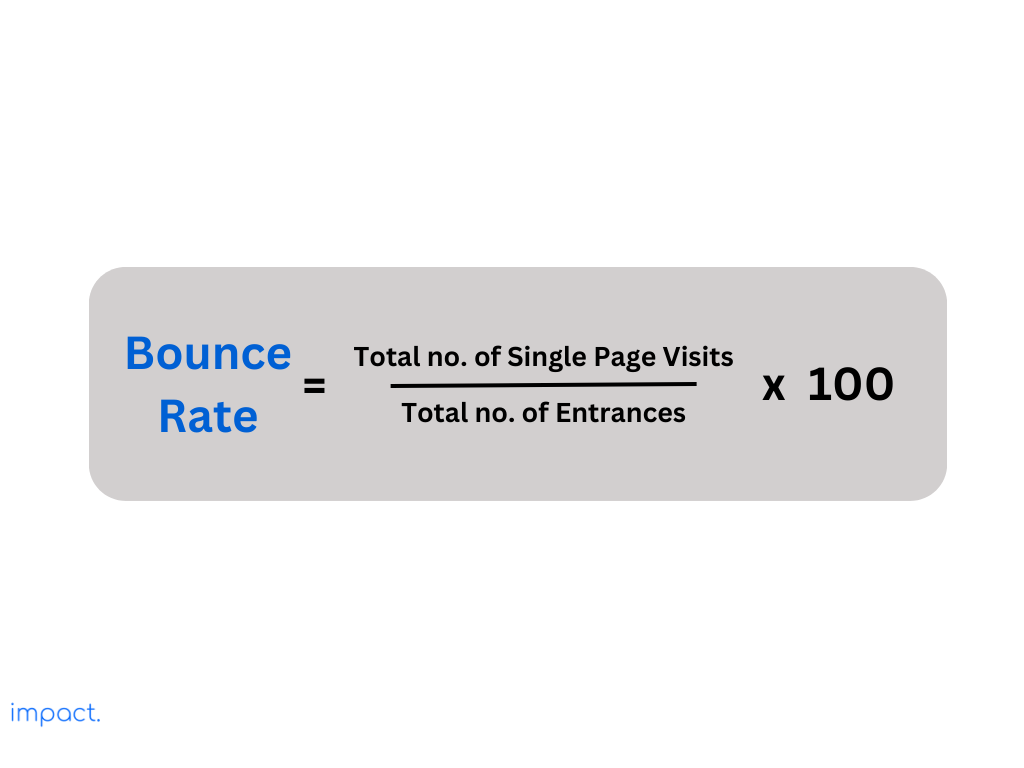
This SEO metric is the percentage of website visitors who do what you want them to do, like buying something or filling out a form. It shows how well your website turns visitors into customers or leads.
Here’s how Google calculates this metric:

Engagement time, or time on page, measures how long visitors interact with your website’s content. It tells you if your content matches what users are searching for.
Longer engagement time means visitors find your content valuable and engaging, showing a positive user experience. Conversely, a short time on a page suggests a disconnect between what the user wants and what your page offers.
To track engagement time on your website, you can use tools like Google Analytics. It provides metrics for average session duration.
When a user starts a new session, Google Analytics begins recording the time in milliseconds. This time is sent to Analytics when any of the following actions occur:
Keyword ranking indicates where your website stands in search engine results for certain words or phrases. Higher rankings mean more visibility and organic traffic because people tend to click on websites at the top of search results.
However, keyword rankings can change often due to various reasons. For example, Google might update its algorithm, you could lose backlinks, or your competitors may publish new content. That’s why keeping an eye on your SEO rankings is crucial.
You can utilize SEO tools like SEMrush or Ahrefs to monitor your keyword rankings. These tools offer features that allow you to track your keyword rankings.
Read more: Mastering Keyword Research in 8 Steps
Backlinks are links from other websites that lead to your website. They show search engines that your site is trusted and authoritative, which can improve your search rankings. Google considers backlinks a crucial factor in determining the credibility and value of your site.
You can use tools like Ahrefs, Semrush, or Moz to keep track of your backlinks. These tools provide valuable information about the links pointing to your website.
It’s important to consistently work on acquiring high-quality backlinks for your site. Here are some popular strategies you can use:
One way to measure SEO involving backlinks is by looking at referring domains. Think of referring domains as online signposts that guide people to your website. When other websites link your site, they create these signposts. Each separate website that links to you counts as a referring domain.
Referring domains matter because when other websites link to yours, search engines view your site as more reliable and significant. They can help your website appear higher in search results.
While referring domains and backlinks are related, they’re not the same. Referring domains count the number of different websites that link to yours. Even if one website often links to you, it’s still considered one referring domain.
On the other hand, backlinks are the individual links that connect one website to yours. Simply put, if five websites have two links pointing to your website, you would have five referring domains and ten backlinks.
Read more: 5 Effective Off-Page SEO Strategies for Building Authority
A website health score is a way to evaluate the overall condition of your website in terms of technical aspects and SEO-related factors. It gives you an idea of how well your website optimization is for search engines and user experience.
The great thing about the health score is that it shows you any changes compared to previous evaluations, including specific errors that affected the score. A high website health score means your website is well-optimized, leading to better visibility on search engines and a positive user experience.
Various SEO auditing tools assess different aspects of your website to calculate the health score. These tools look at factors such as how fast your site loads, how friendly it is for mobile devices and any technical SEO problems it might have.
When search engines can’t crawl or index certain pages on your website, it’s an index coverage error. Fixing these errors is important because it helps search engines find and show your website’s pages in organic search results.
Google may deindex or delay indexing your pages for various reasons. Since index coverage errors often occur unintentionally, it’s crucial to be aware of them and fix any issues.
You can use Google Search Console to identify and resolve index coverage errors. This tool provides detailed reports on problems related to crawling and indexing.
Page speed is how fast your web pages load for people visiting your website. When your pages load quickly, it makes the user experience better. It reduces the number of people leaving your site right away. It can also positively impact how search engines rank your website.
You can use tools like Google PageSpeed Insights or GTmetrix to check your page speed. These tools will give you information and suggestions for improving page loading times.
Read more: Technical SEO: Definition and 7 Key Steps to Take
Now that you understand the important metrics for measuring and tracking SEO performance, it’s time to explore the available tools. These tools come in handy for assessing various aspects of your website’s visibility, rankings, and traffic. Here are some commonly used options for measuring SEO performance:
Google Analytics is a free and popular web analytics tool that gives detailed information about your website’s visitors, what they do on your site, and whether they convert into customers. It helps you track how much traffic you get from search engines, which keywords drive that traffic, and how engaged your users are.
Having a fast and functional website is important for SEO. If your website is slow to load, hard to navigate, or has many errors, people won’t want to stay on it. Luckily, Google has a tool called Google Search Console to help you find and fix these issues. By using this tool, you can improve your search ranking.
Google Search Console provides useful information about how your website appears in Google search results. It tells you how many times your website appears in searches, how many people click on it, and the rate at which people click through to your site. It also helps you find and fix any problems with how Google crawls and indexes your site. On top of that, it provides an analysis of the keywords that are driving traffic to your site.
Google Trends is a useful tool that lets you check how popular certain keywords or topics are and how often people search for them. It can help you spot trends at specific times of the year, assess how well certain keywords are doing, and gain insights into how people search for things.
Google PageSpeed Insights (PSI) is a tool from Google that checks how fast your website loads on computers and mobile devices. It gives you tips on how to make your site more quickly and better for users. After testing your site, PSI gives it a score between 0 and 100. The higher the score, the faster and more efficient your website is. PSI also gives you suggestions on how to make improvements.
Ahrefs is a helpful tool for improving your website’s search engine optimization (SEO). It offers a range of features like keyword research, backlink analysis, competitor analysis, rank tracking, and site audits.
With Ahrefs, you can see important information about your website, such as backlinks, keywords, and page performance, all in one place. It’s useful for tracking your SEO over time and making smarter decisions about your content.
SEMrush is a comprehensive SEO tool offering various features to enhance your website’s performance. With SEMrush, you can conduct keyword research, analyze backlinks, audit your site, and track your rankings. It also provides valuable insights into your competitors’ strategies.
The tool makes it simple to discover, monitor, and utilize keywords, track your backlinks, and compare your SEO with your competitors. Additionally, you can obtain keyword reports to assess whether your website has gained or lost rankings for specific keywords.
Mom offers various SEO tools, including keyword research, link analysis, rank tracking, and on-page optimization. They provide metrics like Domain Authority (DA) and Page Authority (PA) to assess website strength.
Moz aggregates SEO information into a paid dashboard and offers free tools for keyword checking, measuring SEO performance, and providing daily updates through MozCast. Their Google Algorithm Update History explains major shifts in SEO performance due to algorithm changes.
GTmetrix is an excellent tool for checking how well your website is doing in terms of SEO. It focuses on website speed and performance. With GTmetrix, you can find out how fast your website loads, its pages’ size, and other essential performance details.
GTmetrix examines your site’s performance and suggests ways to make it better. For example, optimize your images, use browser caching, or reduce the time it takes for your server to respond. GTmetrix also gives you helpful charts and historical data to see how your site’s performance has changed.
Screaming Frog is a helpful tool for website owners and marketers to see how well their sites are doing on search engines. It finds problems that need fixing to make your site show up better on Google and others.
It’s also great for conducting technical site audits. The tool looks through everything and finds broken links, duplicate content, and slow pages. It checks how your site is set up, like the main words and the maps for search engines. It even looks at how well your site works on phones, whether it’s secure with HTTPS, and whether the web addresses work correctly.
This article emphasizes the importance of measuring SEO performance and understanding key metrics to assess your efforts’ effectiveness. You should track specific metrics that provide valuable insights to evaluate your SEO performance.
These metrics help you measure how well your website is doing regarding visibility, organic traffic, user engagement, and overall SEO success. By paying attention to these key metrics, you can use data to make informed decisions and improve your website’s performance.
Remember, SEO is an ongoing process that requires continuous evaluation and adjustment. It’s important to be proactive and adapt to the ever-changing digital landscape. Understanding and using these key metrics can improve your website’s visibility, attract organic traffic, and achieve your SEO goals.
Impact Insight Team
Impact Insights Team is a group of professionals comprising individuals with expertise and experience in various aspects of business. Together, we are committed to providing in-depth insights and valuable understanding on a variety of business-related topics & industry trends to help companies achieve their goals.
See how our software provides better value.
Speak with our consultant to explore how we can improve your accounting, processes, and people.

Warehouse managers need to understand the importance of measuring warehouse performance. It is crucial to measure performance because it helps companies keep track of trends, assess efficiency, and identify any problems that may arise.
When it comes to measuring warehouse performance, there are different approaches you can take. You can begin with the traditional method or utilize specific metrics or Key Performance Indicators (KPIs) tailored for warehouses. In this section, we will describe alternative methods for measuring warehouse performance.
Measuring warehouse performance is essential for companies to understand how well their warehouses operate. It helps them in a few key ways:
When warehouse managers can identify issues, evaluating and fixing them becomes more manageable. There are many ways to measure warehouse performance, all aimed at objectively assessing and evaluating warehouse activities.
Read more: Understanding Warehouses: Definition and its Importance
According to Ackerman (2003), measuring warehouse performance involves focusing on four key areas:
Performance management effectively manages various aspects of a company’s operations and economic performance. According to Slack et al. (2001), high-performance procedures can be described as follows:
To effectively measure performance, it’s essential to monitor how well you meet the criteria that matter to your customers and how well you manage costs.
The figure below shows that different industries have different ideas about what matters most in measuring performance. It illustrates the Key Performance Indicators (KPIs) that retailers find essential and the ones that their third-party logistics service providers prioritize.
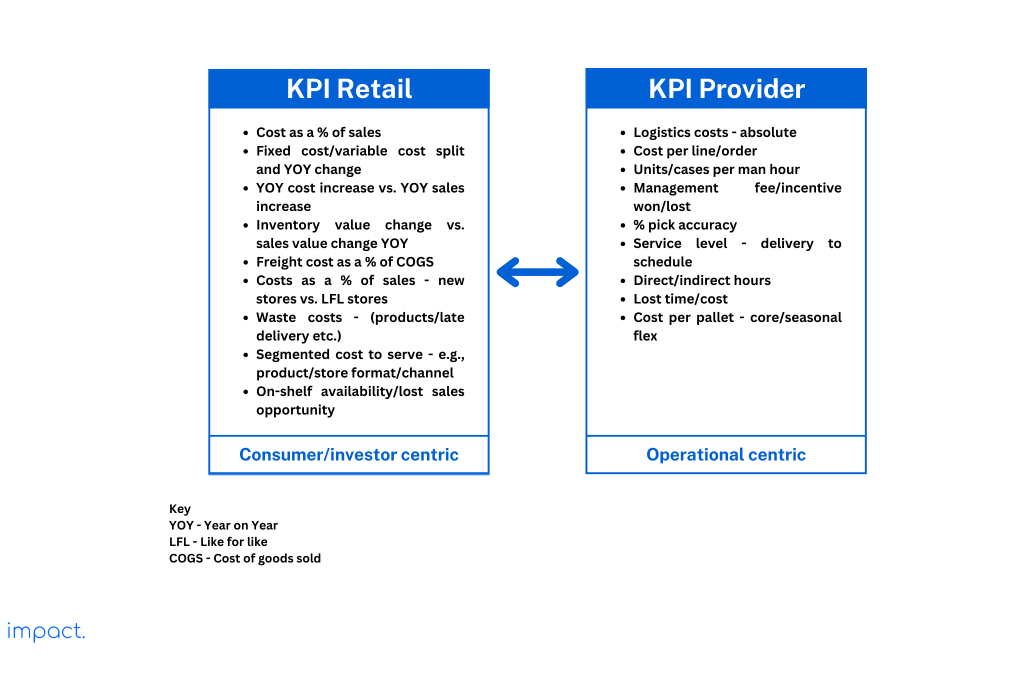
To effectively measure performance management, it is crucial to record and analyze the time it takes to complete various tasks in the warehouse. Consider the following factors when measuring these activities:
There are several ways to measure warehouse performance management, and each method has its benefits. Different companies have different priorities, customers, and ways of doing things. To choose the best approach, you should follow these steps:
The first step in creating a sound performance measurement system is understanding the company’s vision and how your department can help achieve its goals. Sometimes, department heads develop performance measures they find comfortable and easy to achieve. Still, these measures don’t match the company’s vision and don’t interest senior managers.
It’s essential to follow the SMART approach to achieve success. Your actions should meet the following criteria:
Moseley (2004) and Vitasek (2004) suggest the following tips for introducing KPIs:
Companies can choose from six different methods to measure warehouse management performance. Let’s take a look at each type of measurement method:
In today’s warehouses, we use several traditional ways to measure productivity. These measures fall into four main types:
| Hours worked: (Hours worked × 100) ÷ hours worked available |
| Warehouse area utilization: (Used space × 100) ÷ available space |
| MHE utilization: (used MHE hours × 100) ÷ available MHE hours |
In financial terms, a cost measure represents a percentage of sales and the cost incurred per order shipped. To calculate this measure, follow these steps:
| Percentage cost of sales: (Total warehousing costs × 100) ÷ total sales revenue |
| Order costs shipped: Total warehouse cost ÷ total number of orders shipped |
| Picked units per hour: Units picked ÷ total available hours |
| Delivery accuracy : Unit selected ÷ total hours available |
| Timely delivery: Orders shipped according to customer requests ÷ total orders received |
OTIF (on time and in full) is one of the most commonly used metrics in the UK today. It combines with the perfect order metric, the most popular measure of customer service. To meet the OTIF standard, we must deliver items on time, without any damage, and ensure they have the correct documentation and labeling. Moreover, accurate invoicing is crucial.
Let’s break down the calculation for the perfect sort percentage. We measure four metrics individually and then multiply them:
To find the perfect order metric, we multiply these percentages: 97% × 98.5% × 99.5% × 98% = 93.2%.Now, let’s focus on the OTIF (On-Time-In-Full) measurement. It considers two metrics: on-time delivery and delivery in full. The yield for OTIF is calculated as 97% × 98.5% = 95.5%.
Additionally, our latest warehouse measurements include inventory evaluations. When assessing inventory, we should measure the following aspects:
To calculate the stock turnover, divide the current stock level by the total annual sales and multiply the result by 365. You can calculate this using the actual number of units in stock or the stock value. This calculation helps us determine how many days’ worth of stock we have.
For example, let’s look at the table below. It shows that product code 99172100 has been in stock at the warehouse for two and a half years. On the other hand, product code 90152100 has only been in store for five days.
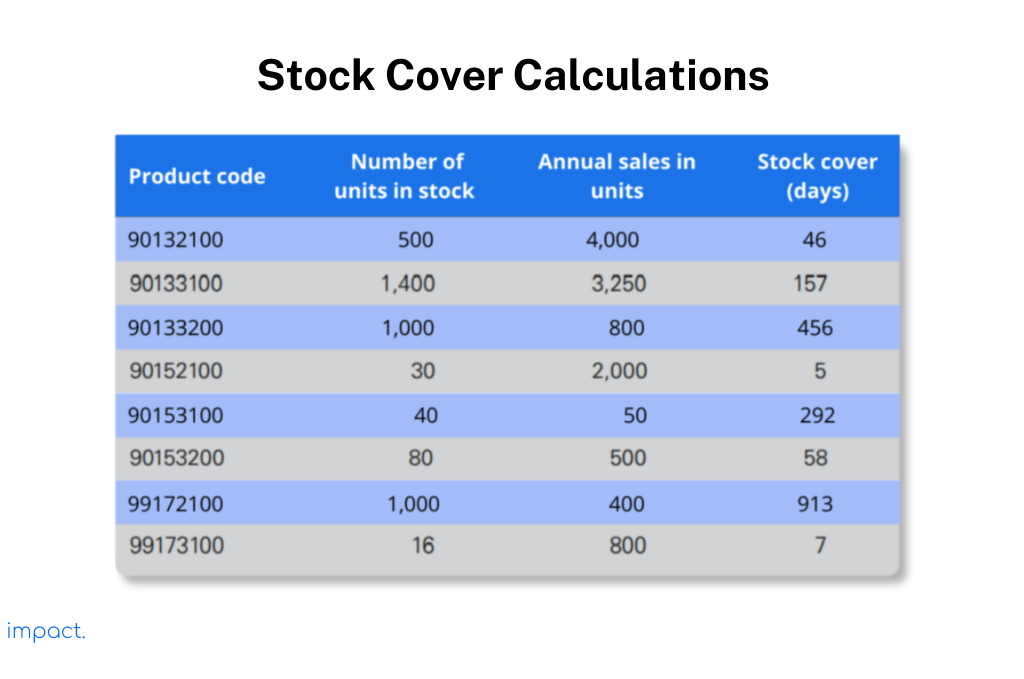
To calculate stock turnover, divide the total units sold by the average number of units available. For example, product 90132100 sold eight units in the past, which is considered reasonable. However, product code 99172100 only had a stock turnover of 0.4, meaning the stock turnover was less than once yearly.
This calculation helps determine stock ordering policies and decide whether to return stock to producers, discard it, or launch sales campaigns.
Inventory measurement includes assessing stock accuracy, which ensures efficient order fulfillment. Whether you count stock once a year, twice a year, or daily using cyclical or perpetual inventory counting methods, maintaining accurate stock levels is crucial. The more precise your stock records are, the better your chances of fulfilling orders correctly and increasing overall efficiency.
To measure stock accuracy, follow these steps:
To determine the extent of damage in the warehouse, you can measure it in two ways. First, divide the damaged goods by the total number of items processed through the warehouse. Second, assess the monetary value of the damage.
| Percentage of damaged items = items found to be damaged ÷ items shipped per month |
The measurement forms mentioned earlier are known as hard measures. They are relatively easy to measure, concrete, and straightforward. In contrast, soft measures refer to intangible qualities.
For instance, consider customer satisfaction with prompt delivery as a soft measure. Soft measures effectively capture perceived changes and provide a more comprehensive understanding of success than narrow-focused strict measures.
Although it can be challenging, soft measurement can be defined and measured. For example, we can use a survey with a rating scale from 1 to 10 to assess user satisfaction. This survey can be repeated at appropriate intervals to track perceived changes in service.
Research conducted by Landrum et al. (2009) highlights reliability and responsiveness as the most critical factors for service quality. Reliability factors include:
The integrated performance model blends actual performance data and customer perceptions. We gather data from performance reports and send questionnaires to customers regularly.
We assign ratings based on survey results and actual performance, which produce scores. We use red, yellow, and green models to highlight poorly performing areas. Red areas require attention.
When measuring performance, make sure your actions match customer requirements and expectations. For example, delivering 100 percent of available warehouse items doesn’t always mean fulfilling the exact customer order quantity.
Benchmarking is when a company compares its performance with other companies or operations. The goal is to discover what successful companies do to achieve high performance.
Companies use benchmarking to:
When benchmarking, it’s important to collaborate, keep things confidential, provide value, be flexible, honest, open, and maintain a good reputation. One way to keep things hidden and anonymous is to involve outside parties like benchmarking groups, consultants, or universities.
Kaplan and Norton (1996) created the balanced scorecard, which tracks performance. It assesses aspects like finance, customer satisfaction, internal processes, staff development, and innovation.
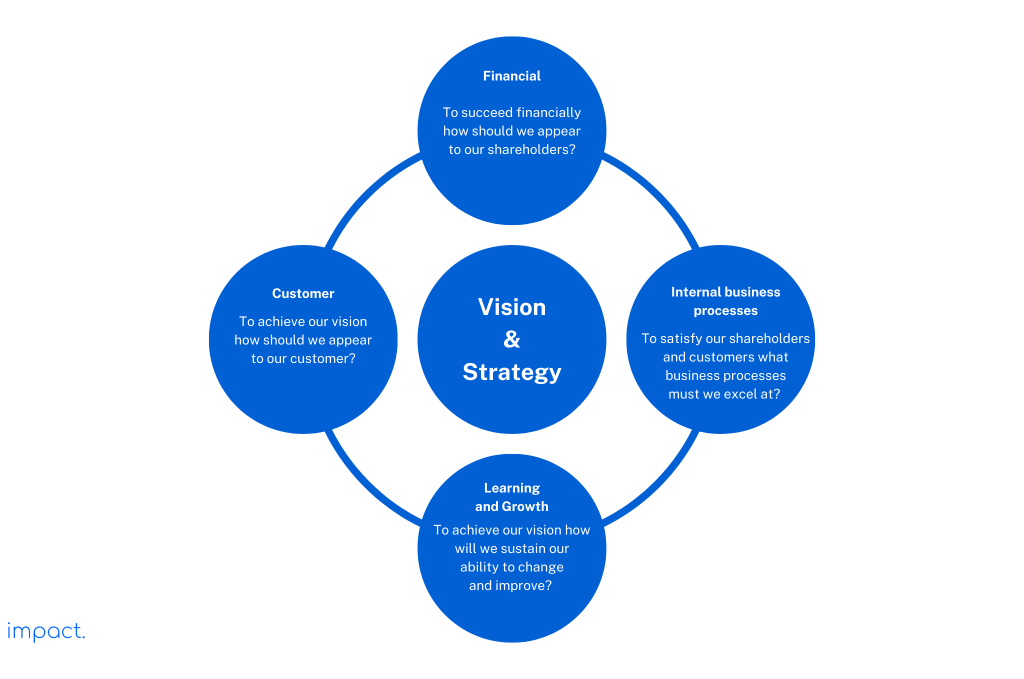
We will set goals and targets for each measure and measure them against actual performance. By implementing a balanced scorecard approach, we aim to improve processes, motivate teams, increase customer satisfaction, and enhance communication.
Read more: Warehouse Manager: Roles and 10 Challenges to Overcome
To achieve efficient operations, measuring performance effectively by following SMART steps that align with the company’s strategic vision is essential.
It’s worth noting that traditional KPIs report the status of an operation or process at a specific time. While they help compare performance over time, adjusting targets and actions is crucial as the environment changes quickly.
There are many performance measures related to warehouse operations. However, it’s best to measure only the areas that matter to your customers and your company.
Richard G. 2011. Warehouse Management. Great Britain: Kogan Page Limited.
Impact Insight Team
Impact Insights Team is a group of professionals comprising individuals with expertise and experience in various aspects of business. Together, we are committed to providing in-depth insights and valuable understanding on a variety of business-related topics & industry trends to help companies achieve their goals.
See how our software provides better value.
Speak with our consultant to explore how we can improve your accounting, processes, and people.
